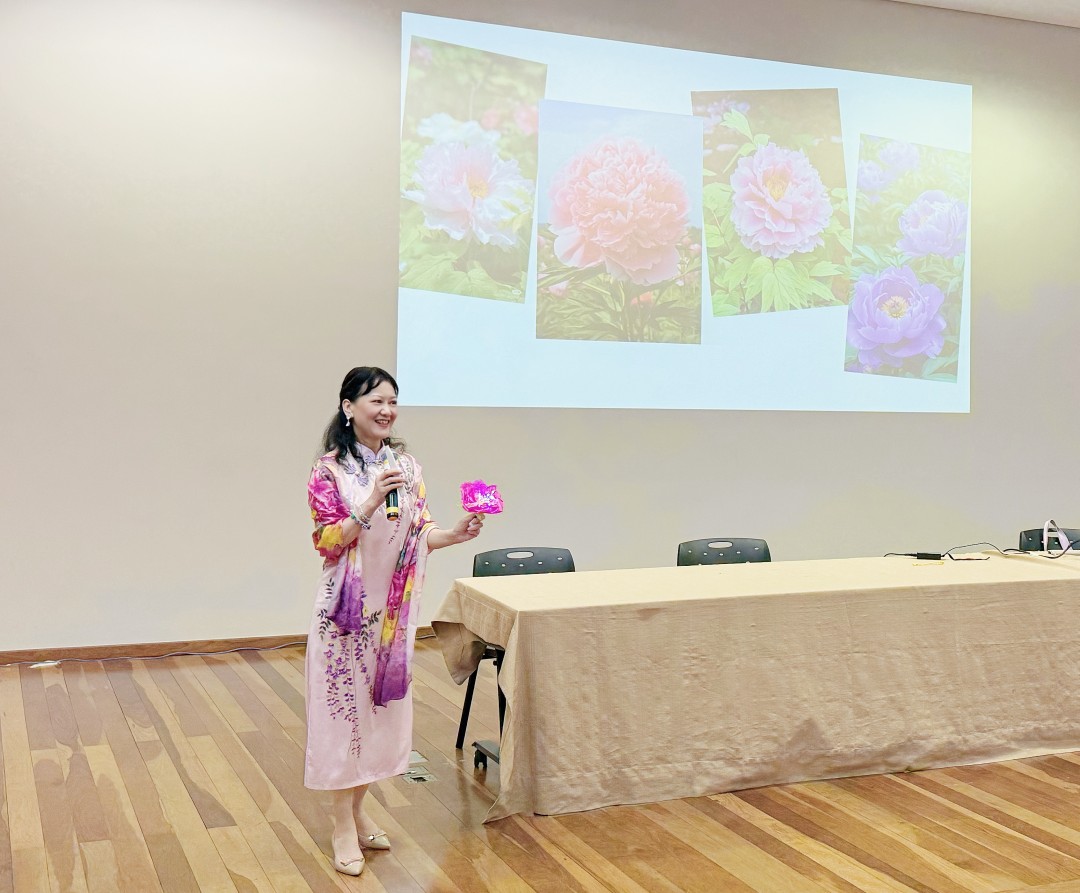Peonies Serve as a Bridge Connecting China and Brazil, Filling the Campus with the Fragrance of Culture

In April, when the refreshing autumn breeze sweeps through the southern hemisphere, a grand cultural feast, with peonies as the medium and Chinese characters as the vessel, unfolds on the campus of the Federal University of Minas Gerais in Brazil. On April 16 local time, the cultural garden party "Peony Expressions · An Invitation from Heze: A Gathering in Brazil", jointly organized by the Confucius Institute at the Federal University of Minas Gerais and the Publicity Department of the Chengwu County Committee in Shandong Province, was held here. Using flowers as messengers and culture as the bond, the event celebrated the 16th International Chinese Language Day.
Peonies as a Brush: Painting a Scroll of Civilizational Integration
"Peonies are the millennium-old messengers of Chinese civilization, embodying the beautiful implication of 'blooming in prosperous times'," said Cui Guangying, the Chinese director of the Confucius Institute at the Federal University of Minas Gerais, in her speech at the event. Taking peonies as a starting point, she told more than a hundred teachers and students about the legend of Cangjie creating Chinese characters, cultural allusions, and the origin of the saying "The peonies of Caozhou are unparalleled under heaven". Her vivid narrative made the Brazilian teachers and students feel as if they were in the peony gardens of Heze, truly experiencing the profound heritage of Chinese cultural symbols.

During the interactive Q&A session, students actively participated, eager to answer questions. What they gained were not only peony dolls and panda-themed cultural creations but also a beautiful encounter with Chinese civilization amidst laughter and joy. "Chinese culture is like a blooming peony, with each petal hiding a touching story," marveled Maria, a student, holding her prize.
Ink, Brush and Tea: Traditional Arts Nourishing the Soul
At the event site, Director Cui Guangying's improvised ink-wash painting of peonies became the focus of attention. Dipping her brush generously in ink, her strokes flowed like a dragon soaring and a phoenix dancing. The petals were rendered with layers of ink wash, and the stamens were depicted in exquisite detail. Soon, the painting National Beauty and Heavenly Fragrance came to life on the paper. A Brazilian professor from Birkbeck, University of London, exclaimed, "This peony seems to carry the fragrance of the East, allowing me to witness the thousand-year inheritance of Chinese culture."

In the calligraphy experience area, Director Cui personally guided students in brushwork. "Lifting the brush is like a peony bud blooming, and pressing down is like its petals stretching open," she explained patiently. Under her demonstration, students used brushes to write Chinese characters such as "harmony" and "love", feeling the shared aesthetic charm between Chinese characters and peonies through the rhythm of the strokes. Not far away, the melodious sound of the guzheng filled the air as Teacher Pan Yunan, dressed in Hanfu, presented a tea art performance. From warming the cups, placing the tea leaves, brewing to serving the tea, every step was executed with grace. Students sipped the fragrant tea, savoring the artistic conception of "Fine tea is like a fair maiden", and appreciating the calm and profound essence of Chinese culture amidst the aroma of tea and the melody of music.
Hanfu Elegance: A Cultural Dialogue Across Time
As soon as more than ten sets of Hanfu were displayed in the Hanfu experience area, students rushed to try them on. Wearing peony hair accessories and holding oil-paper umbrellas, they posed for photos in front of the display board with the words "The peonies of Caozhou are unparalleled under heaven". "The encounter between Hanfu and peonies allows me to touch the essence of Chinese culture," exclaimed Andy, a student, voicing the thoughts of many participants. Groups of "Hanfu messengers" strolled through the campus. As their clothes fluttered, Eastern aesthetics and South American charm collided, creating a unique spark.
Fun Interactions: Cultural Resonance at Your Fingertips
In the ring-toss game area, Chinese delicacies such as Want Want rice crackers and White Rabbit Creamy Candies were arranged in the shape of peonies. When students successfully tossed a ring onto the snacks, cheers mingled with the exclamations from the peony paper-cutting booth, pushing the event to a climax. "These snacks are not only delicious but also make me feel the cheerful atmosphere of Chinese folk culture," said Carlos, a student, excitedly holding his "trophies". In the paper-cutting workshop, student Ana skillfully cut out the outline of a peony with red paper and showed it off excitedly, exclaiming, "It turns out that scissors can also 'plant' flowers!" At the rubbing booth, auspicious patterns like "May all go well" were carefully printed, carrying the Brazilian youths' yearning for a better life.
Flowers as a Medium: Nurturing the Evergreen Tree of Friendship
"The clouds remind me of her dress, the flowers her face. This poem is as beautiful as peonies!" recited Zhu Xun, a student majoring in Chinese, as she copied Li Bai's famous line onto a peony-patterned postcard, expressing her admiration for Chinese culture. On the message wall, messages such as "I want to visit Heze to see the real peonies", "The friendship between China and Brazil will last forever", "Let's embrace the Chinese language together and admire the peonies of Heze", and "Flowers bloom in China, and their fragrance spreads to Brazil" decorated the "wish tree" like petals, showing the Brazilian teachers and students' love for Chinese culture and their beautiful expectations for Sino-Brazilian friendship.
Miriam Mansur, the foreign director of the Confucius Institute at the Federal University of Minas Gerais, said, "Peonies have enabled Brazilian teachers and students to understand the profoundness and romance of Chinese culture. Such exchange activities are vivid practices of building a community with a shared future for mankind." As the sun set, the event ended with the melody of Jasmine Flower. However, the fragrance of cultural integration had already spread far and wide amidst laughter and joy.





